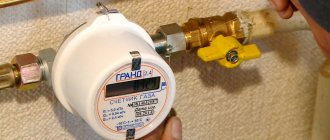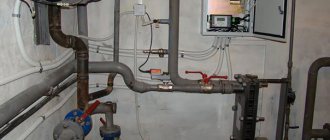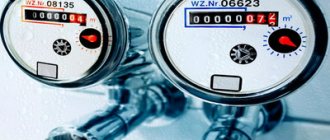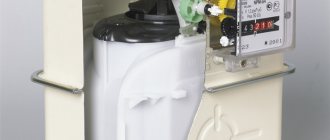Federal Law No. 261 of November 23, 2009 speaks of the need to install metering devices in residential buildings connected to centralized energy supply systems. This document refers to both collective (shared) and individual meters for water, electricity, heat and gas.
In this article, we will look at whether everyone is required to install individual gas meters. We'll tell you about the installation procedure and how and where to submit readings.
Who needs to install gas meters
Article 13 of Federal Law No. 261 states that the requirement to install gas meters does not apply
for dilapidated, emergency, objects subject to demolition or major repairs before January 1, 2013, as well as for those apartments or houses in which:
- less than 2 m3/hour is consumed,
- heating is carried out without the use of gas-using equipment.
If the house is heated with gas, then the gas consumption is more than 2 cubic meters per hour, and you are required by law to install a meter.
Types of gas meters
The principle of operation, as well as the design of the gas meter, depends on its purpose, power supply, measurement mechanism, as well as on throughput.
Main categories
There are two main types of gas metering devices. These are mechanical and electronic devices.
- Mechanical gas meters. In this case, the measuring mechanism is directly affected by the gas, moving at a speed depending on the pressure in the line. The fuel flow drives an element that transmits data to the counting device.
- Electronic meters. These models have an LCD display. Sensors that almost instantly send corresponding impulses are responsible for accurately determining the volume of incoming gas. Their quantity is immediately recorded, then recalculated and converted into flow meter indicators.
It cannot be said that one of the types has serious advantages over its competitor. The list of advantages of mechanical models includes a simple operating principle, easy maintenance, and complete independence from the functioning of the electrical network. The advantages of electronic gas meters are maximum accuracy and longer service life. However, their main disadvantage is their higher price.
Difference between designs
If we consider this equipment by type of design, it can be divided into 5 large groups.
Drums
These types of gas meters are used where maximum, standard accuracy of the devices is important. For example, in institutes, factory laboratories. The main element of the device mechanism is a measuring drum, divided into 4 equal sections. It is connected to the counter.
The container contains a barrier liquid (oil, water). Under the influence of gas pressure, the blades inside the drum rotate, and the 4 chambers are alternately filled or emptied. When turned, the section is released, allowing access to the gas device. In this case, neither the degree of gas purification nor temperature affects the measurements.
Vortex
These devices are also not the simplest designs, so they are practically not used in domestic conditions. In this case, pressure fluctuations are assessed. They are provoked by the creation of vortices inside the chamber. To do this, a “blimp body”—a truncated prism—is placed inside the device. Thanks to this obstacle, a vortex motion begins when gas is supplied.
All vibrations in the medium are read by two sensors, which guarantee the accuracy of the data due to their insensitivity to any interference - acoustic or vibration. Due to the correctness of measurements, vortex gas meters are used in industrial enterprises and for the needs of housing and communal services.
Membrane (diaphragm)
Such devices are most often found in everyday life. Their advantages are ease of operation and maintenance, accuracy when measuring small volumes of gas. The design consists of several (two, four) chambers connected together by a system of valves and channels. Gas entering the first chamber fills the space, after which the second one opens. When it is filled, a membrane connected to a mechanical counter pushes a portion of gas to the stove burner.
Since the volume of the chambers is known, gas calculation is simple. The valves are controlled using a crank-lever mechanism. Advantages of membrane devices: long service life, long verification interval (10 years), low price. Disadvantages: noise (“whistle”), large dimensions. Therefore, these gas appliances are not ideal for apartments of any size, since they cannot be hidden everywhere.
Rotary
This is another type of small mechanical model that can be called universal. Such gas meters are successfully used in domestic conditions, in industrial enterprises, and in boiler rooms. They are quite reliable, trouble-free, and can easily withstand short-term loads. The main working elements of the structure are two rotor blades, which begin to rotate due to the pressure created by the gas.
The number of revolutions is recorded by a mechanical counter. The minimum distance between the moving elements and the body of the device guarantees the accuracy of the readings. The advantages of rotary devices are good throughput, durability, compactness, and almost silent operation. The downside is the short verification interval (only 5 years).
Turbine (tachometer)
In this case, the principle of operation of the gas meter is slightly different: what is happening here is not determining the number of revolutions, but estimating the rotation speed of the working element, the turbine. The value depends on the gas pressure; the number of revolutions is accurately recorded by the counting device. It can be either mechanical or electronic.
Turbine gas meters are simple, reliable, and have high throughput. However, the large dimensions allow the devices to be used only in industrial enterprises. Another relative disadvantage is the dependence of the accuracy of the readings on the continuity and stability of the gas flow. In pulsating mode, the error increases.
Is it possible to install for free?
Part 11 of Article 13 of Federal Law No. 261 allows for this possibility. Find out which categories of citizens in your city can receive money for installing meters from the local administration or your district government.
A subject of the Russian Federation or a municipal entity has the right to provide at the expense of budget funds
constituent entities of the Russian Federation, the local budget,
support for certain categories of consumers by allocating funds to them for the installation of metering devices
for used energy resources, intended for payments for used energy resources.
Standards
Residents of apartments in which meters are not installed pay for used gas according to the following standards:
- 12 m3 per person for those households where only a stove is installed; in terms of money, this amounts to slightly less than 60 rubles per person. per month;
- 24.5 m3 for owners of a gas boiler or water heater, which in money amounts to about 120 rubles per person.
If meters are not installed on time
If gas meters have not yet been installed in your apartment (house) in 2021, despite the fact that the room is heated with gas, be prepared for a visit from gas workers.
The fact is that the resource supplying organization, according to the same Federal Law-261, is obliged to install metering devices for you if you have not done this on time (before January 1, 2021). And they will do it forcibly. You are obliged to let them into the apartment (house) to carry out work and must pay for their work. If you refuse to pay, you will be additionally required to reimburse the costs incurred by the organization due to the need for enforcement.
It is possible to pay for the forced installation of metering devices in installments. The entire cost of installation services provided must be paid within 5 years. This possibility is provided for by Part 12 of Article 13 of the above-mentioned Federal Law No. 261.
Agreement
, regulating the conditions
for installing
a collective or individual (common for a communal apartment)
metering device
for the energy resource used (the supply or transfer of which is carried out by the specified organizations) and concluded with the citizen - owner of a residential building, garden house or a person authorized by him, with the citizen - owner of the premises in apartment building or the person responsible for the maintenance of the apartment building, in order to fulfill their duties provided for in parts 5 - 6.1 of this article,
must contain a condition on payment of the price
determined by such an agreement
in equal shares within five years from the date of its conclusion, except in the case of , if the consumer has expressed his intention to pay the price determined by such an agreement in a lump sum or with a shorter installment period
. When a provision for installment payment is included in such an agreement, the price determined by such an agreement must include the amount of interest accrued in connection with the provision of installment plans, but not more than in the amount of the refinancing rate of the Central Bank of the Russian Federation in effect on the date of accrual, except in cases where the corresponding compensation is carried out at the expense of the budget of the constituent entity of the Russian Federation, the local budget.
Residents of Crimea and Sevastopol still have time to install gas meters. Federal Law No. 261 sets a deadline for these regions until January 1, 2021.
Where is the gas meter installed?
The location of the devices depends entirely on the building. For example, in apartments, gas meters are installed in kitchens - on a branch that comes from a common riser, and is intended for connection to any consumer: to a stove, a water heater, a boiler. According to the standards, the device is allowed to be mounted in kitchen cabinets, but in this case, the owners must ensure free access to the device, as well as its secure fixation on the wall.
In private homes, it is possible to place the gas meter on the external walls - in a special cabinet or under a canopy. However, with such an installation, several conditions must be met: there should be no power lines near the device, and vehicle passage in the immediate vicinity is also prohibited. For ease of access to the device at any time, one of the keys is transferred to the management company.
Which organizations have the right to install gas meters
Only gas distribution organizations that have the appropriate license can install meters.
Employees of these companies have permission to carry out gas hazardous work. In Moscow, for example, this is JSC Mosgaz. Some websites on the Internet now offer to install meters cheaply and without turning off the gas. Such companies often do not have any information about the legal entity on their website - only phone numbers. These are scammers. Contacting such “specialists” is life-threatening.
Economic expediency
For example, consider two options:
1. Apartments with only a gas stove.
As already mentioned, installing gas meters (Law No. 261) in this case is optional, but maybe it’s really beneficial? We count.
The average family of 3 people lives in an apartment with centralized hot water supply, heating and no gas meter. The consumption rate in this case is 10 m3/person. At a tariff of 4.50 per m3, the family will pay 135 rubles per month. If you install a metering device, it turns out that residents on average consume no more than 5–6 cubic meters of gas per month, which means they will have to pay about half as much, that is, about 70 rubles, and this is in the most extreme case, but in practice it usually works out far less. However, if you calculate all the costs of purchasing and installing a meter, you can see that it will pay off in eight to ten years. But there is one more nuance: if 3 people live in your apartment, and, for example, seven are registered, then the savings can be very significant.
2. Apartment equipped with a stove and water heater.
To make the comparison more accurate, let's take the same family of three. The rate of gas use in such a situation is 24.5 m3/person. With the same conditional cost of a cubic meter of blue fuel, we have:
24.5 x 4.50 x 3 = 330.75 rubles.
Based on practice, we can say that in fact in such houses the meter “runs up” significantly more than the standard, especially in winter. So many consumers who installed meters were unhappy with this situation: with the installation of a meter, they have to pay more - about 400-450 rubles. But there is also a peculiarity here: the fact is that the water heater and boiler are used only a few months a year, and in the summer the payment for gas using a meter becomes meager. Thus, the total amount for the year will still be much less than the standard amount.
Gas meter installation procedure
- Buy a meter.
You can find out which meter to choose from the gas distribution organization that services your home.
Consult with specialists - they will tell you which type of meter is best suited in your case and what bandwidth is required. When purchasing, be sure to check the accompanying documentation for the device. There must be a technical passport, which must contain a mark on the date of factory verification. The date of manufacture of the device and the calibration interval must also be indicated there.
Check the serial number indicated on the meter and in your passport. They should be the same.
- Apply for installation.
Call the gas distribution organization in your city or region and ask to install a meter.
You can also apply online on the organization's website. A specialist will first come to you to inspect the premises and assess the scope of work. Sometimes you can install a meter quickly and easily, without carrying out welding work, and sometimes you need to change the gas distribution inside your apartment. You will need to sign an agreement and pay for the required list of works.
When installing the meter, specialists will definitely turn off the gas riser. After the meter is installed, the gas engineer will draw up a work completion certificate, a strict reporting form and a gas meter installation certificate. One copy of each document must remain with you. The installation certificate will be stamped in the meter's passport. But that is not all.
- Seal the meter and put it into operation.
The sealing will be carried out by representatives of your resource supply organization - the regional branch of Gazprom LLC.
You can contact them by calling or filling out an application online on the website. Specialists will come to you, seal the meter, take readings and tell you the personal account number for which you will submit readings every month.
Is it beneficial for tenants to install meters?
In conclusion, it is worth understanding how profitable it is to install accounting equipment. Such counting devices are beneficial for tenants who have a water heater or boiler. If there is only a stove in the room, then installing a meter becomes pointless.
Installation of equipment will cost about 5 thousand or more. The final cost of all work is determined by the cost of the electronic meter and the company’s services for installing the equipment.
Meters are installed to save payment for consumed blue fuel . Experts have determined that one person consumes no more than 3 cubic meters of gas per month. If there is no meter, then payment is charged for the average standard, which is 10-13 m3 per month. Each cubic meter of fuel costs approximately 5.5 rubles.
If there are four people living in a family, they will pay 220 rubles/month for gas. If a meter is installed, the amount will be only 44 rubles. It turns out that with the meter the savings are 176 rubles per month. If you calculate the installation cost, the device will pay for itself in less than 2.5 years.
If we compare premises with a gas water heater, then for each person the norm per month will already be 25 cubic meters of gas. But in fact it is equal to approximately 10 cubic meters. It turns out that installing a gas meter in such a situation will pay for itself in even less than 2 years, which is extremely profitable.
The advantages of using gas meters are obvious. But there are also disadvantages . Firstly, you will have to spend a lot of money on the device itself and its installation. Secondly, it will be necessary to carry out maintenance of accounting equipment at certain intervals. The rest is all advantages and savings.
Is gas meters required to be verified?
As is the case with water meters, gas meters need to be checked periodically, since any measuring instrument can become inaccurate over time.
The verification interval and date of manufacture are indicated in the meter's passport, so you need to save it after purchase and track the moment when verification is required. Some meters do not require checking for 10 years, and some need to be checked every 3 years. This depends on the type and specific brand of the device - the calibration period is set by the manufacturer.
Conducting verification is the responsibility of the owner of the apartment (house) in which the metering device is installed. The verification procedure itself can only be carried out by specialists: your regional branch of the gas distribution organization or other organizations authorized to carry out such work.
Recommendations and installation procedure
So, it was decided to install a gas meter. Where to contact?
Such equipment cannot be installed independently; only special services have the right to carry out such work. You need to contact a specialized office like Gorgaz.
To install a gas meter, you will need to perform a number of actions:
- Write an application to Gorgaz, attach copies of ownership papers.
- Specialists from the gas service organization will determine the availability of technical capabilities to install the necessary equipment.
- An estimate is drawn up and the necessary equipment is purchased.
- Then the specialists install a gas meter, after which the owner pays for all work performed.
Once the equipment is installed, it must be sealed. To do this, you need to contact the management company with a corresponding application.
Upon installation, a special report is drawn up, which indicates the device number, date and location of installation, initial readings at the time of installation and the date of the next gas meter check.









